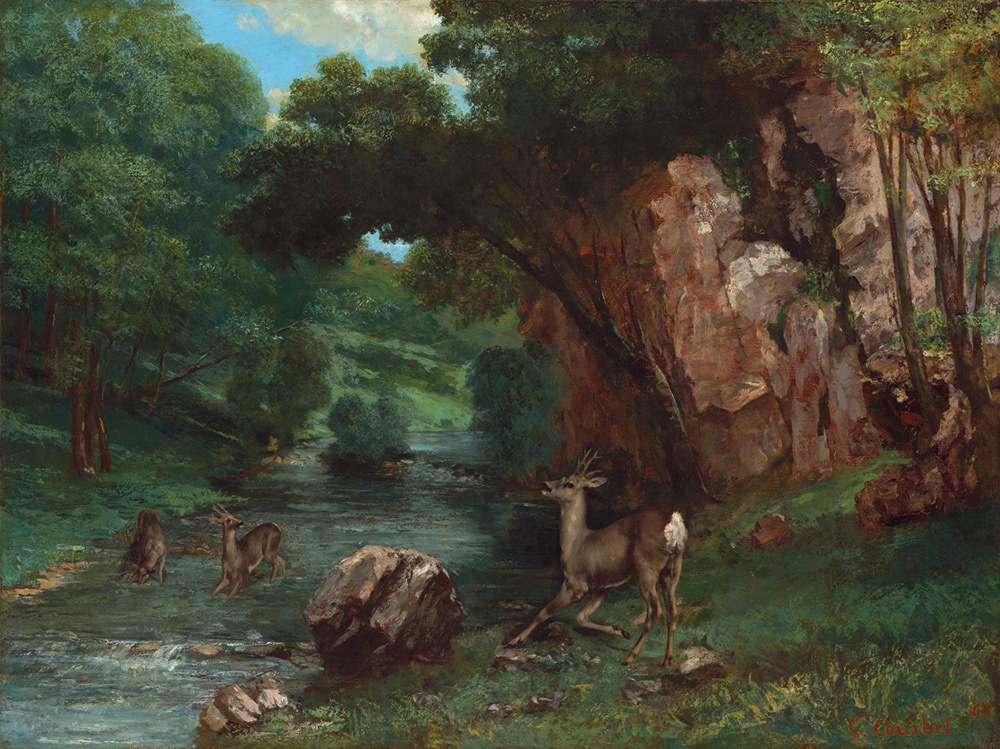From September 22, 2018 to January 6, 2019, Palazzo dei Diamanti in Ferrara will host the exhibition Courbet and Nature, an exhibition entirely dedicated to French painter Gustave Courbet (Ornans, 1819 - La Tour-de-Peilz, 1877) and his relationship with nature.
Courbet, a provocative artist, the father of realism and a man with a complex personality, was also an excellent landscape painter, who considered nature his main source of inspiration: it is no coincidence that two-thirds of his production consists of panoramas, views, foreshortenings, horizons, and rural moors, in which the protagonist is the natural element.
Gustave Courbet, moreover, is returning to Italy for the first time after about fifty years since the last exhibition dedicated to him, and Palazzo dei Diamanti pays tribute to him with an important retrospective that recounts the career of the great French master, delving, in particular, into his considerable production of landscapes and his unique relationship with nature.
The exhibition presents about fifty canvases from the most important international museums and takes the visitor on an itinerary that promises to be interesting. The landscapes of his native region, Franche-Comté, occupy a special place in the artist’s heart: the lush valley of the Loue, arid plateaus, rushing rivers, undergrowth and immense skies are reworked in endless and surprising variations. Also a source of inspiration were the places where he had the opportunity to stay or which he visited during his lifetime, such as the Mediterranean coasts near Montpellier, the rocky landscapes of the Meuse region in Belgium, the Normandy marinas with swollen waves before breaking on the rocks, or the Swiss lakes painted in exile in an atmosphere charged with nostalgia. These subjects are complemented by paintings with the theme of nudes and animals in the landscape, where Courbet once again demonstrates that he is the bearer of an original view of the world, but also that he is aware of the great Western pictorial tradition, studied at the Louvre.
Gifted with a rare sensitivity, his personal but realistic view of the world led him to profoundly innovate painting. His works, keeping poised between the echoes of Romanticism and the reflections of an Impressionism that was taking its first steps in those very years, represented a sure model of reference for Manet, Monet, Degas and companions.
An engagé artist and a great painter of female nudes, Courbet always preferred the depiction of natural elements, en plein air or in the studio, even when he was confronted with the social themes that made him famous, or when he focused on simple scenes of everyday life. With Courbet, art became emancipated from classical and romantic ideals, and the real and nature became the pivots around which to revolve the narratives of his own era, as close to reality as possible.
In this sense, his passion for the natural world led him to “photograph” the innermost corners of the places to which he went in the course of his frequent travels (Paris, his native Ornans and its environs, the coasts of Normandy and the Mediterranean, Germany and Switzerland), returning to us all the realistic, and at the same time lyrical, feeling of those humid undergrowths, immense skies, seas, streams, waterfalls, streams and caves.
With Courbet and Nature, the Italian public will thus be able to rediscover the work of one of the greatest painters of the 19th century, an artist who left an indelible mark on his era by managing to ferry French art from the Romantic dream to the crude painting of reality, and from this to a new love of nature.
There are ten sections in the exhibition: a prologue that introduces Gustave Courbet’s artistic and human personality through two masterpieces such as The Wounded Man and The Oak of Flagey, followed by “Cartloins of Franche-Comté,” “The Figure and Nature,” “The Mediterranean,” “Caves,” “Travels and Comparisons,” “Still Life: Landscapes of Nostalgia,” “Seascapes,” “Switzerland,” and “The Hunt.”
The exhibition is curated by Dominique de Font-Réaulx, Barbara Guidi, Maria Luisa Pacelli, Isolde Pludermacher and Vincent Pomarède and organized by the Ferrara Arte Foundation and the Ferrara Galleries of Modern and Contemporary Art. For information you can log on to the Palazzo dei Diamanti website.
Pictured: Gustave Courbet, Roe Deer at the Spring (1868; oil on canvas, 97.5 x 129.8 cm; Fort Worth, Kimbell Art Museum)
 |
| Gustave Courbet at Palazzo dei Diamanti with a major exhibition on his relationship with nature |
Warning: the translation into English of the original Italian article was created using automatic tools. We undertake to review all articles, but we do not guarantee the total absence of inaccuracies in the translation due to the program. You can find the original by clicking on the ITA button. If you find any mistake,please contact us.